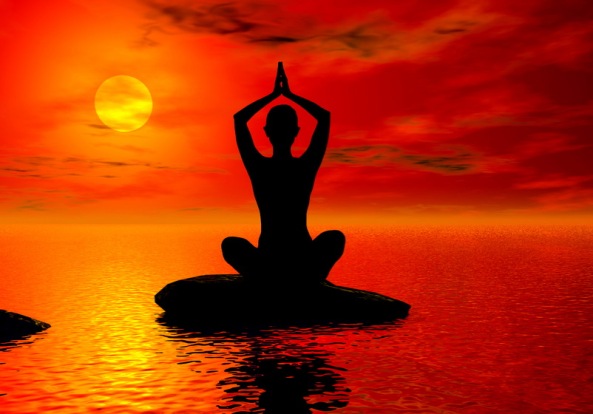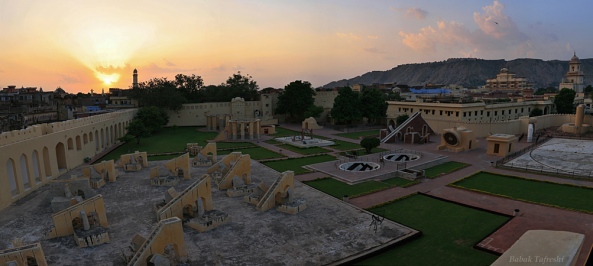
As Hinduism is rich in diversity it comes as natural that it will offer more ways to achieve its goal. Those four ways for attaining the ultimate goal are Raja Yoga, Karma Yoga, Bhakti Yoga, Jnana Yoga. Four main types of Yoga are designed to suit different temperaments or attitudes toward life. The Sanskrit word Yoga has many meanings. The root of the word is “yuj,” meaning “to control,” “to unite.” Its translations include “joining,” “uniting,” “union,” “conjunction,” and “means.” It is said that all four types of Yoga lead ultimately to the same destination – freedom from endless cycle of birth and rebirth, to union with Brahman or God.
It is necessary to mention that by Yoga we don’t mean the “Yoga classes” or certain Yoga exercises that are promoted in woman’s magazines. Don’t get me wrong, there is nothing wrong about practicing such kind of Yoga. Those exercises can definitely make your spine and joints more flexible, keep you physically in good shape, but this alone will not bring you much closer to the ultimate goal. Those exercises are called Asanas (Sanskrit asana – posture) and they are one part of Raja Yoga.
Raja Yoga is a comprehensive method that emphasizes meditation and uses physical asanas and breathing control. Parts of Raja Yoga which are commonly offered in Yoga classes in the West are Hatha, Kundalini, Ashtanga, Vinyasa, Bikram Yoga and the various forms of meditation. Since it is known that for clear mind, the body should also be in a good shape, or as Romans would say Mens sana in corpora sano (A healthy min in a healthy body), this meditative type of Yoga contains Asanas for the purpose of making the body fit enough so that person could experience the full gains of meditation.
Karma Yoga is the path of action, hard work and selfless service to others and focusing on honesty in everyday action. It could take many forms and be practiced in many ways. The selfless work of volunteers who are donating their time and effort to help people in disasters or protect the wildlife or the environment or any other valid cause are practicing Karma Yoga. World famous example of such type of selfless service is Mother Theresa (1910 – 1997), a catholic nun of Albanian origin and Indian citizenship, who founded the Missionaries of Charity in Calcutta, India in 1950. For over 45 years she ministered to the poor, sick, orphaned, and dying, while guiding the Missionaries of Charity’s expansion, first throughout India and then in other countries. Following her death she was beatified by Pope John Paul II and given the title Blessed Teresa of Calcutta. She won the Nobel Peace Prize in 1979 and India’s highest civilian honor, the Bharat Ratna, in 1980 for her humanitarian work. At the time of her death it was operating 610 missions in 123 countries, including homes for people with AIDS, leprosy and tuberculosis, public kitchens, orphanages, and schools.
Talking about selfless service, a quote from L. Ron Hubbard, American philosopher, writer and humanitarian, comes to my mind: “A being is only as valuable as he can serve others.”
Jnana Yoga is the intellectual path, the path of knowledge, wisdom and contemplation. It involves deep exploration of the nature of our being and the use of our minds for achieving the higher states of consciousness. Jnana Yoga praises self-control, self-discipline and stability of mind. I am sure you can find many examples of this Yogic path.
The one whom I would like to mention here as an example is Professor Stephen Hawking, British theoretical physicist and cosmologist, lifetime member of Pontifical Academy of Sciences (scientific academy of Vatican) and Honorary Fellow of Royal Society of Arts. While being physically disabled and almost completely paralyzed, professor Hawking is of truly brilliant mind. His scientific books and public lectures made him an academic celebrity. His cosmological research of the beginning of the Universe is on the edge between scientific and religious study. And if you ever heard that the universe is expanding but don’t know why is that said or what is the proof of it, I invite you to visit website of professor Hawking and read the transcripts of his public lectures. It helped me to really understand, for the first time in my life, the scientific evidence that universe does have a beginning. It is a very logical explanation which I fully accepted and felt richer for possessing such a piece of knowledge.
I will not here go into explaining the theory of the expansion of the universe, but will share with you the answer of professor Hawking on the question if he believes in God. Hawking writes “One can imagine that God created the universe at literally any time in the past. On the other hand, if the universe is expanding, there may be physical reasons why there had to be a beginning. One could still believe that God created the universe at the instant of the big bang. But it would be meaningless to suppose that it was created before the big bang. An expanding universe does not preclude a creator, but it does place limits on when He might have carried out his job.”
Bhakti Yoga is the path of devotion, emotion, love, compassion, and service to God. All actions are done in the context of remembering and celebrating the Divine. Ministers of all religions are practicing this path regardless of the name they use to address the Supreme Being or the Divine.
Members of International Society for Krishna Consciousnesses – ISKCON, better known as Hare Krishna movement, founded by His Divine Grace A. C. Bhaktivedanta Swami Prabhupada, emphasize the importance of Bhakti Yoga. Members of ISCKON are known by ecstatically chanting names of the Lord Krishna on the streets and squares of cities around the world.
Choose the type of yoga which suits your personality, ambitions and interests. Following as sincerely as you can and watch miracles happening in your life.




 Hinduism is Vedic religious philosophy whose correct name is Sanathana Dharma, meaning Eternal Law or Eternal Knowledge. It represents the oldest living religion whose beginnings reach in some unknown point in the distant past. It is hard to correctly state the age of Vedas, on which Hindusim is based, as they were carried in oral tradition from generation to generation for thousands of years. They were written down between 3.500 and 4.000 years ago. According to Veda themselves they are trillions of years old and they existed from the beginning of time. It is said they were originally a pure spiritual vibration which existed before the creation of material universe.
Hinduism is Vedic religious philosophy whose correct name is Sanathana Dharma, meaning Eternal Law or Eternal Knowledge. It represents the oldest living religion whose beginnings reach in some unknown point in the distant past. It is hard to correctly state the age of Vedas, on which Hindusim is based, as they were carried in oral tradition from generation to generation for thousands of years. They were written down between 3.500 and 4.000 years ago. According to Veda themselves they are trillions of years old and they existed from the beginning of time. It is said they were originally a pure spiritual vibration which existed before the creation of material universe.
